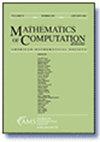Computing the spectral gap of a family of matrices
IF 2.1
2区 数学
Q1 MATHEMATICS, APPLIED
引用次数: 0
Abstract
For a single matrix (operator) it is well-known that the spectral gap is an important quantity, as well as its estimate and computation. Here we consider, for the first time in the literature, the computation of its extension to a finite family of matrices, in other words the difference between the joint spectral radius (in short JSR, which we call here the first Lyapunov exponent) and the second Lyapunov exponent (denoted as SLE). The knowledge of joint spectral characteristics and of the spectral gap of a family of matrices is important in several applications, as in the analysis of the regularity of wavelets, multiplicative matrix semigroups and the convergence speed in consensus algorithms. As far as we know the methods we propose are the first able to compute this quantity to any given accuracy. For computation of the spectral gap one needs first to compute the JSR. A popular tool that is used to this purpose is the invariant polytope algorithm, which relies on the finiteness property of the family of matrices, when this holds true. In this paper we show that the SLE may not possess the finiteness property, although it can be efficiently approximated with an arbitrary precision. The corresponding algorithm and two effective estimates are presented. Moreover, we prove that the SLE possesses a weak finiteness property, whenever the leading eigenvalue of the dominant product is real. This allows us to find in certain situations the precise value of the SLE. Numerical results are demonstrated along with applications in the theory of multiplicative matrix semigroups and in the wavelets theory.计算矩阵族的谱间隙
对于单个矩阵(算子),众所周知,谱间隙是一个重要的量,也是它的估计和计算。在这里,我们在文献中第一次考虑了它对有限矩阵族的扩展的计算,换句话说,联合谱半径(简称JSR,我们在这里称之为第一李雅普诺夫指数)和第二李雅普ov指数(表示为SLE)之间的差。矩阵族的联合谱特征和谱间隙的知识在一些应用中是重要的,例如在分析小波的正则性、乘法矩阵半群和一致性算法的收敛速度中。据我们所知,我们提出的方法是第一个能够计算出任何给定精度的量。对于光谱间隙的计算,首先需要计算JSR。用于此目的的一个流行工具是不变多面体算法,当这一点成立时,它依赖于矩阵族的有限性性质。在本文中,我们证明了SLE可能不具有有限性,尽管它可以以任意精度有效地近似。给出了相应的算法和两个有效的估计。此外,我们证明了当主导积的主导特征值为实时,系统线性系统具有弱有限性。这使我们能够在某些情况下找到SLE的精确值。给出了数值结果以及在乘法矩阵半群理论和小波理论中的应用。
本文章由计算机程序翻译,如有差异,请以英文原文为准。
求助全文
约1分钟内获得全文
求助全文
来源期刊

Mathematics of Computation
数学-应用数学
CiteScore
3.90
自引率
5.00%
发文量
55
审稿时长
7.0 months
期刊介绍:
All articles submitted to this journal are peer-reviewed. The AMS has a single blind peer-review process in which the reviewers know who the authors of the manuscript are, but the authors do not have access to the information on who the peer reviewers are.
This journal is devoted to research articles of the highest quality in computational mathematics. Areas covered include numerical analysis, computational discrete mathematics, including number theory, algebra and combinatorics, and related fields such as stochastic numerical methods. Articles must be of significant computational interest and contain original and substantial mathematical analysis or development of computational methodology.
 求助内容:
求助内容: 应助结果提醒方式:
应助结果提醒方式:


